Exploring the jungles, villages, and coffee shops of northern Laos
Luang Namtha
An unfortunate reality of long-term travel is managing your budget; you can’t do every single tour, trek, zipline, or amusement park that you stumble across. You’ve got to be strategic and spend your money where it counts. But as we researched trekking from our hotel in Chiang Mai in northern Thailand, a place renowned for its trekking, we were faced with a bit of sticker shock. Thailand sees a ton of tourist traffic, and that’s reflected in the prices. Luckily, right next door to Thailand, we found the perfect solution: a small town named Luang Namtha in neighbouring Laos. This town is home to about a dozen tour agencies running treks through the jungle. A three-day trek, including camping and a homestay in a local village, would run us a grand total of $80 each (vs $250 in Thailand). We were sold.
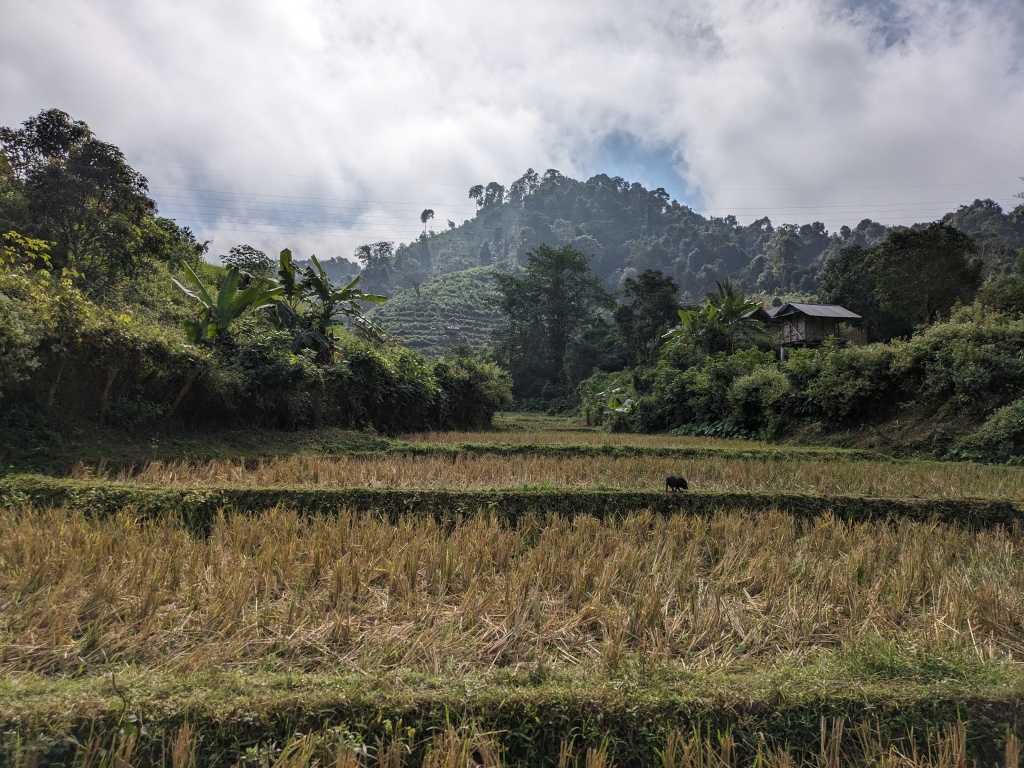
Departing from Chiang Rai in early December, we took a series of buses and shuttles over the Laos-Thailand border along comically horrible roads through the hills, finally landing in Luang Namtha (it took me about three days to realize the name of the town is pronounced “Long Nam Ta”). The town itself is pretty small and not very touristy. With only a handful of hotels and not much English, it was a sharp contrast to bustling, commercial Thailand. We spent a day visiting various tour agencies (we settled on a company called The Hiker) and arranging our trip, then headed off the next morning in a group of eleven (consisting of four Dutch couples/friends, two solo female travelers, and one solo American, plus our two friendly guides) for the jungle.
Day one of our trek started off about 45 minutes outside of town, in a flat, open rice field, full of hot sunshine, low clouds, and plenty of cute farm animals. But we soon found ourselves in the shady and humid jungle of the Nam Ta Protected Area, crossing small streams and heading up steep, muddy embankments beside waterfalls. The hiking was hot and occasionally steep, but we soon arrived at our lunch stop, a lovely viewpoint looking out over Luang Namtha. Here, we were met by some ladies from the nearby village who prepared some amazing fish over the fire for us. We ate it with assorted vegetables and plenty of sticky rice, on a rustic wooden table overlaid with large banana leaves. In the local style, we ate everything with our hands.
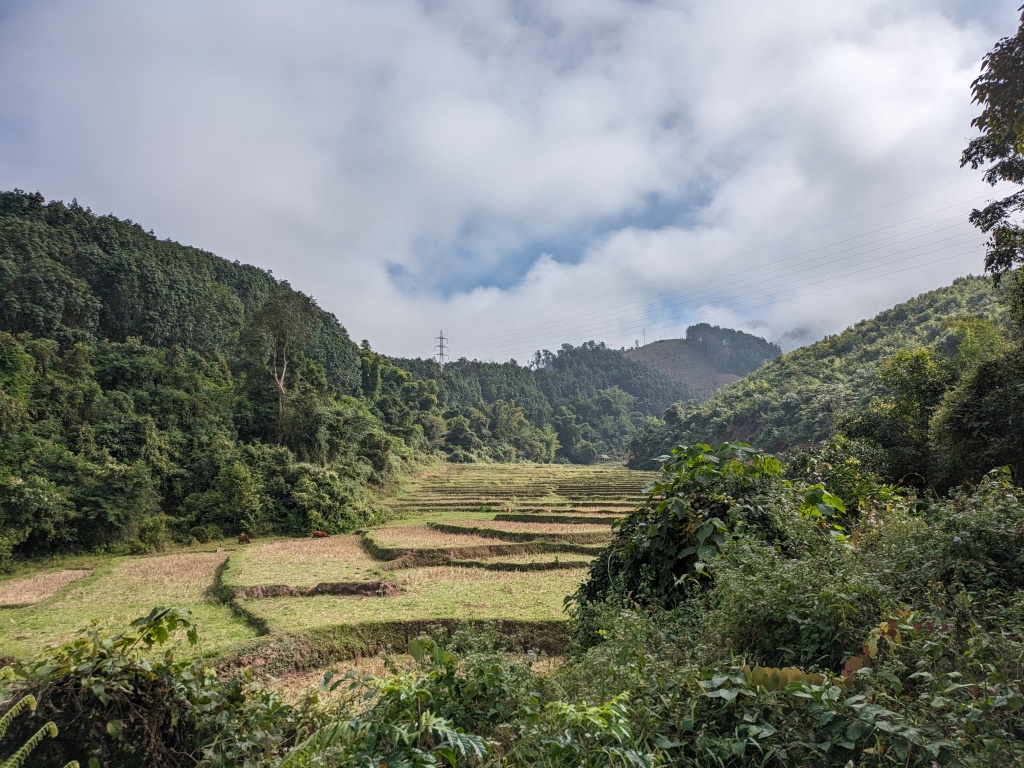
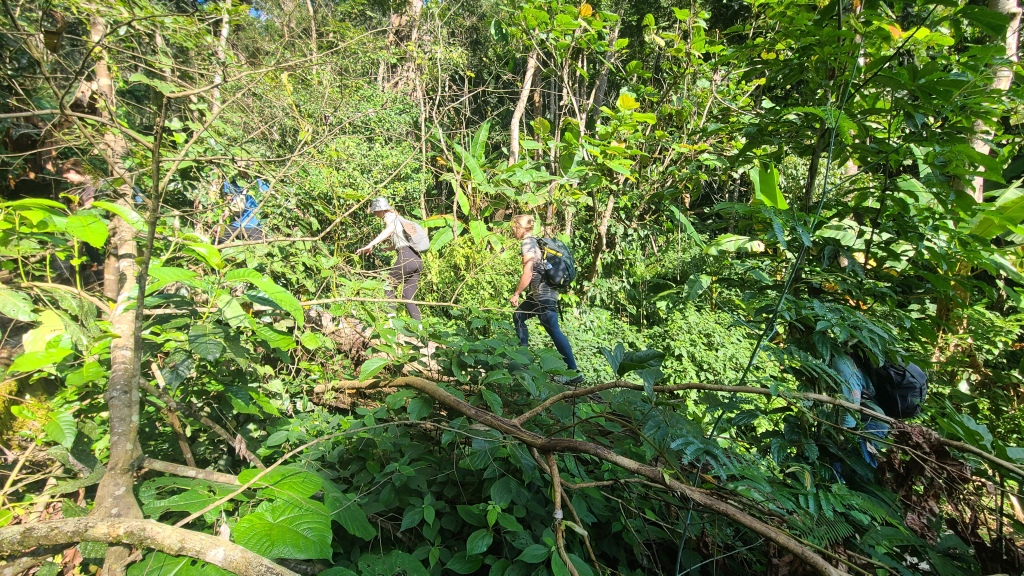
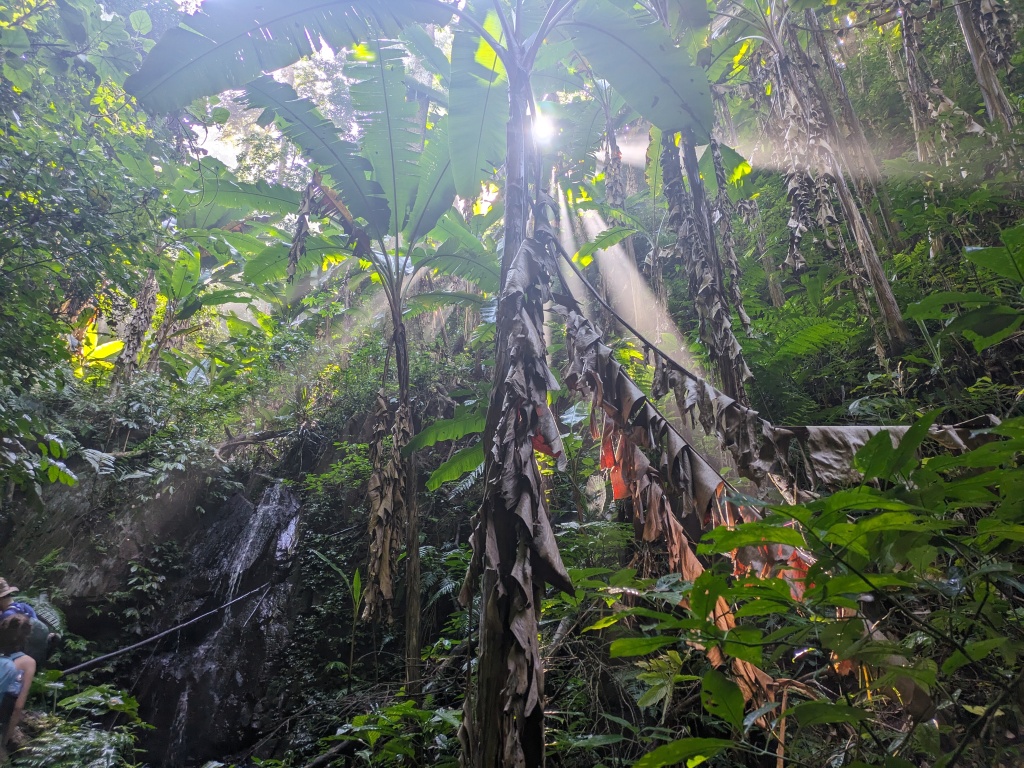
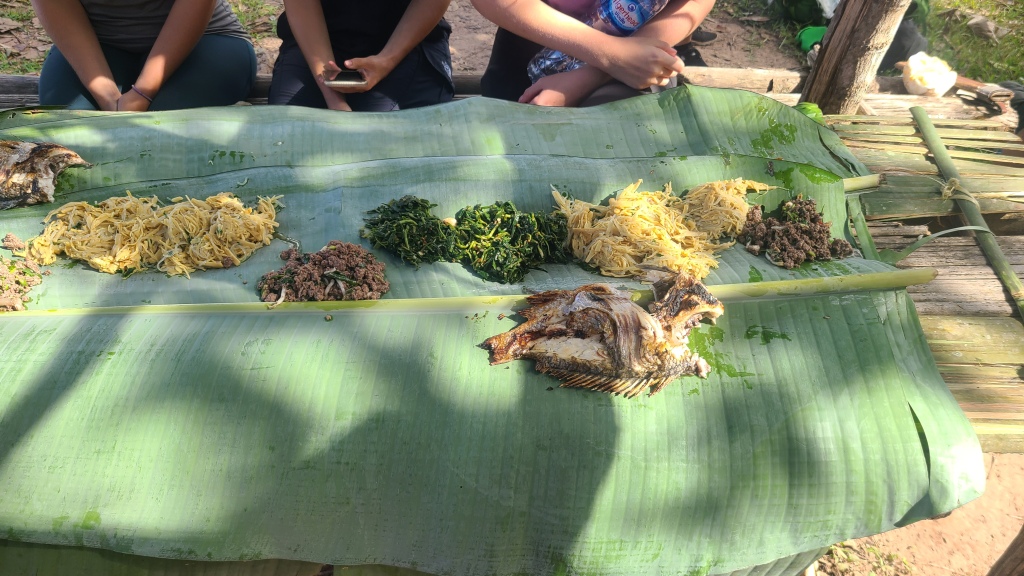
After some more hiking, we arrived in our camp around 3 pm. The camp consisted of a couple small huts (one for sleeping, and one for cooking), plus a table, a fire pit, and a small stream. After a lazy afternoon, we enjoyed a dinner of pork, bamboo soup, tomato salsa, more veggies, and of course more sticky rice, followed by several shots around the table of ‘happy water’, also known as Lao whiskey (which is actually a high-alcohol rice wine).
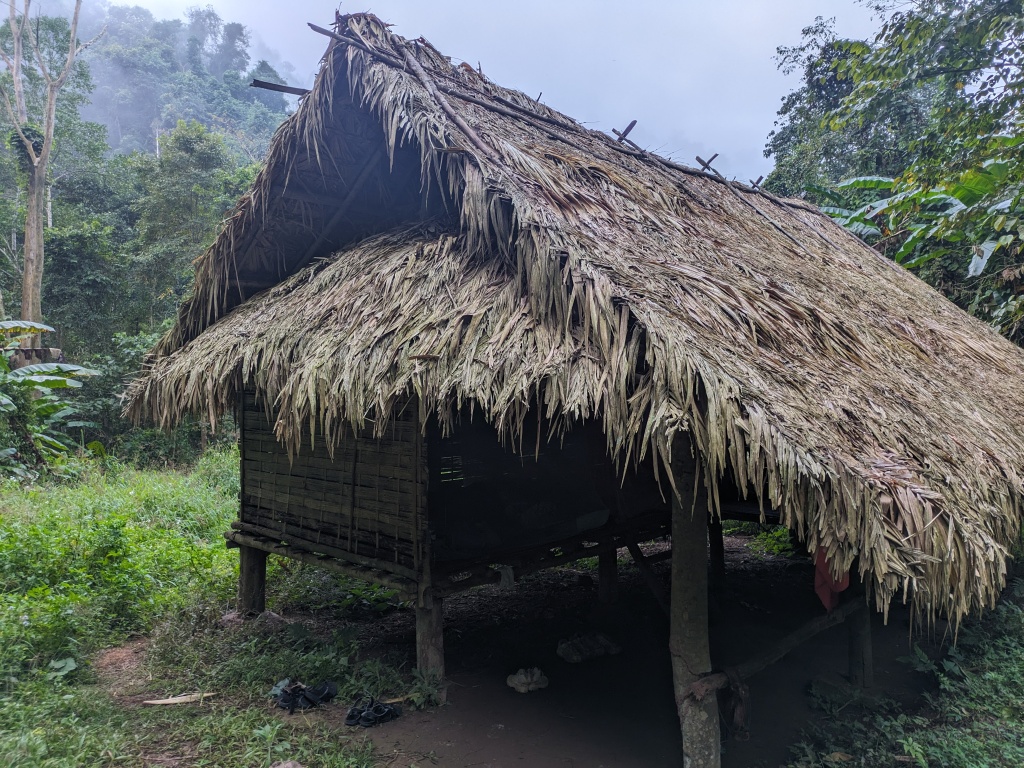
After dinner, we ventured out on a short night walk into the nearby jungle, but we didn’t see a lot: many spiders, a praying mantis, a small frog, and a mouse were some highlights, but nothing big. After some chatting around the campfire, we went to sleep. While Chris and I camp a lot (we spent four months living in a tent earlier this year), and are used to some uncomfortable nights in the wild, this was perhaps the most minimalist sleep set-up I’ve ever had: a bamboo platform with just a thin straw mat, plus a sleeping bag and a mosquito net, and no pillow. I get cold pretty easily, so was a little chilly, but made it through well enough.
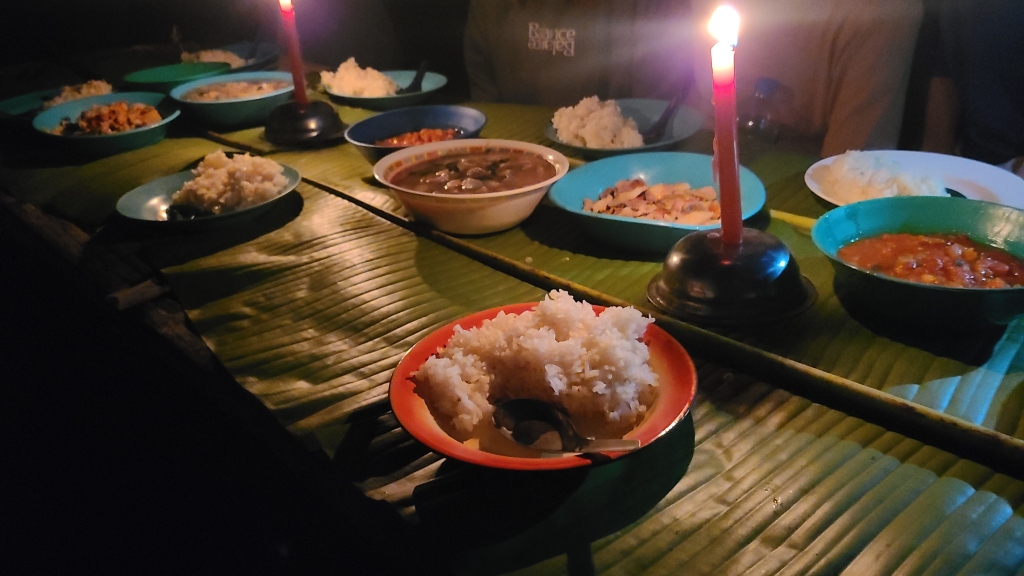
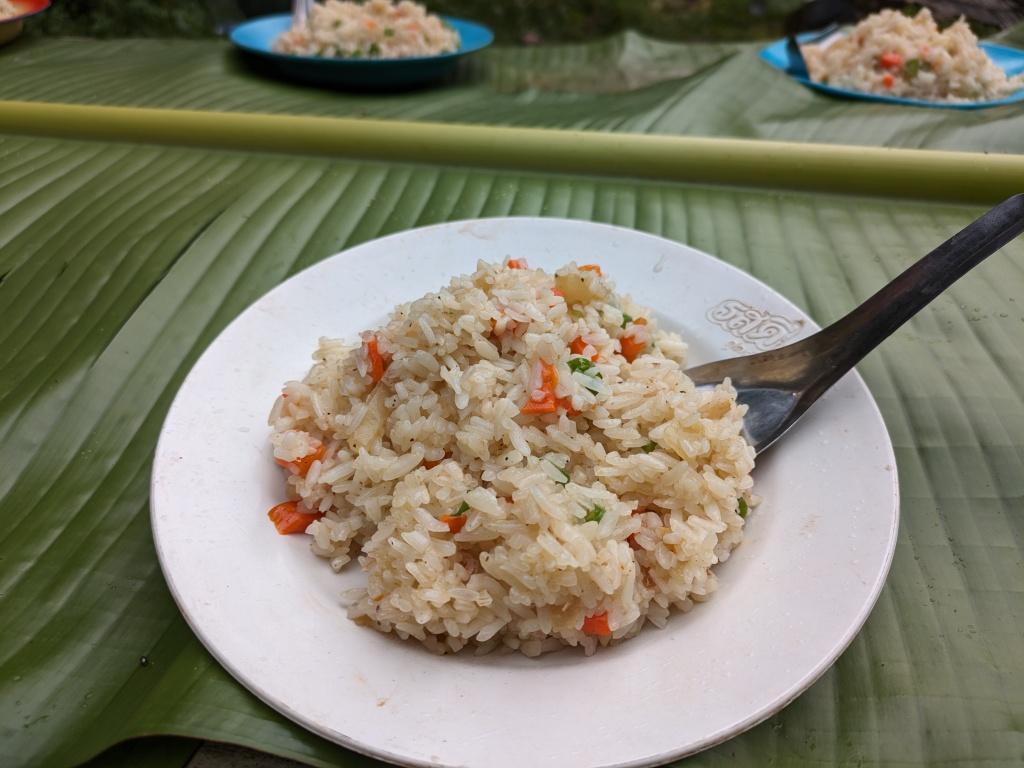
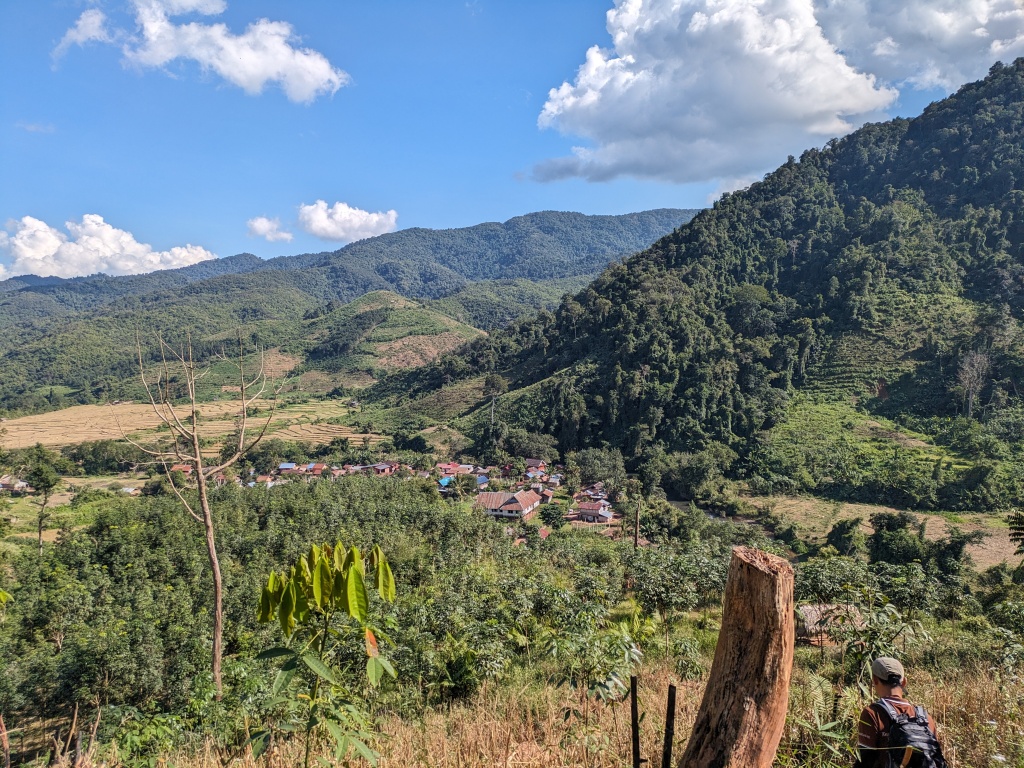
Day two started off with a breakfast of fried rice before we hit the trail again. The second day of hiking was pretty similar to the first, although with a little more bushwacking, and a long stop to whip huge pomelo fruits at other pomelos still high up in the trees (surprisingly amusing). We arrived in our home for the night – a traditional Lao village – around 2:30 pm. After going for a swim in the river, we took a tour around the village in the evening, taking turns to cross a hilariously sketchy bamboo bridge (although bridge is a generous term).
We also got to witness some of the young men and teenagers playing rattanball – a favourite pass time here. Rattanball is basically volleyball played with a small ball made of rattan, except that no hands are allowed. The men used a combination of feet, knees, and headbutts to send the small ball back and forth across the net. I could see the soccer influences as the participants deftly used their feet to control and launch the ball. At one point, the rattan ball flew directly at us as we watched from the sidelines, and Chris (a veteran soccer player) expertly sent the ball back across the net, scoring a winning point (much to the team’s surprise)!
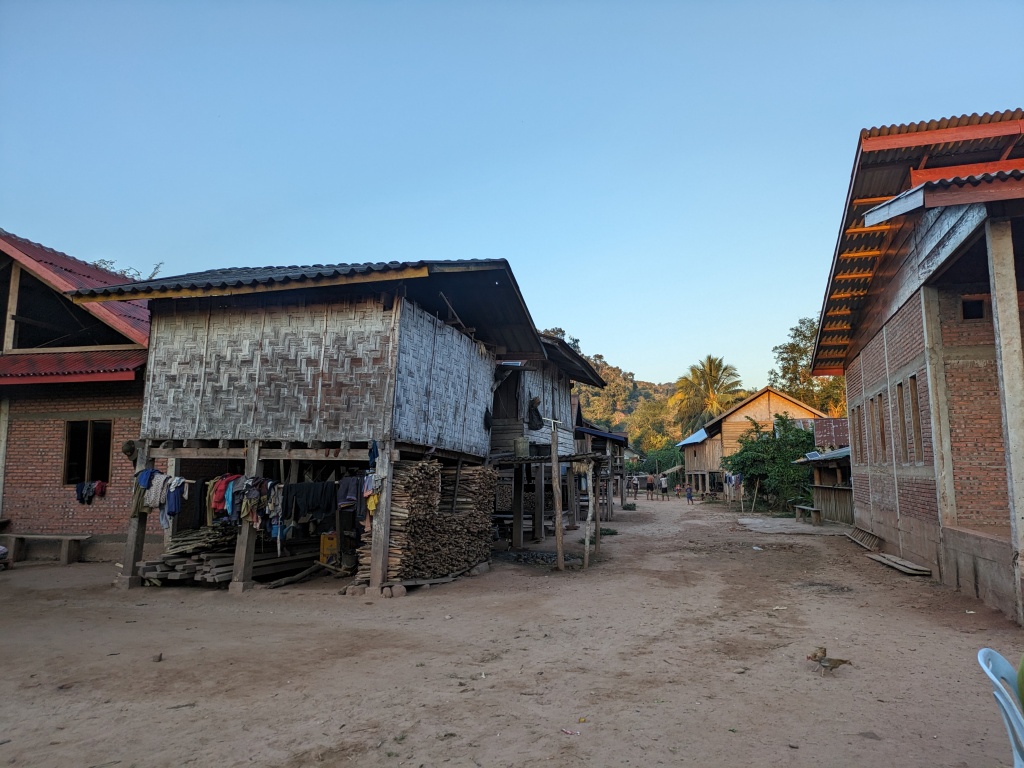
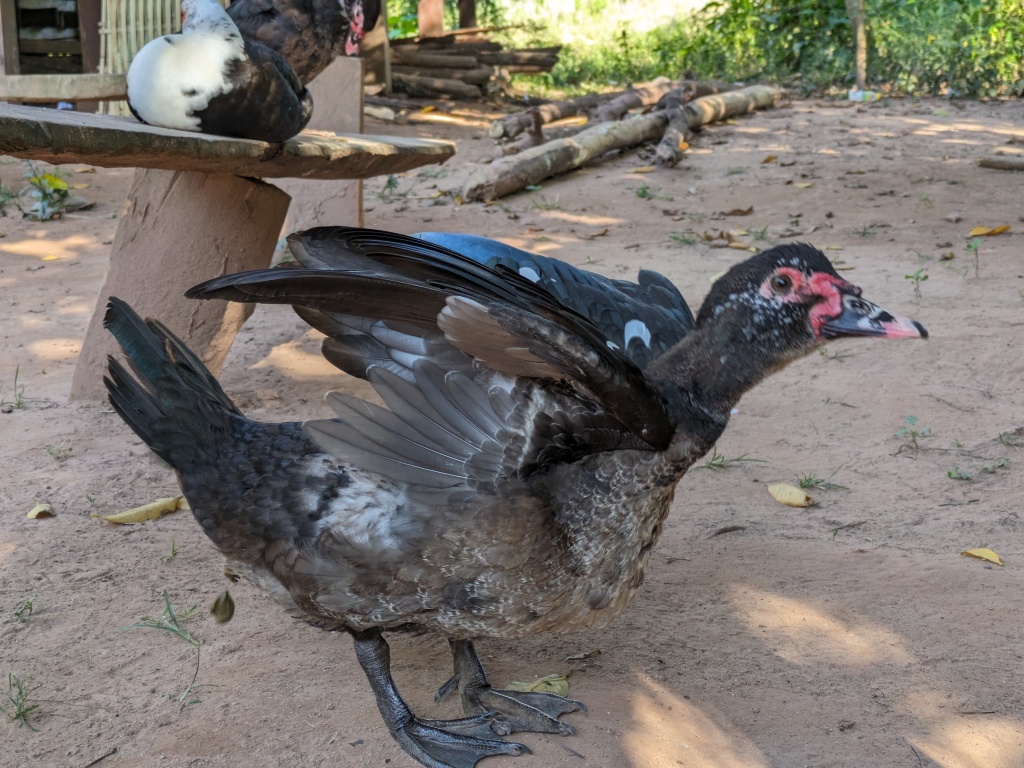
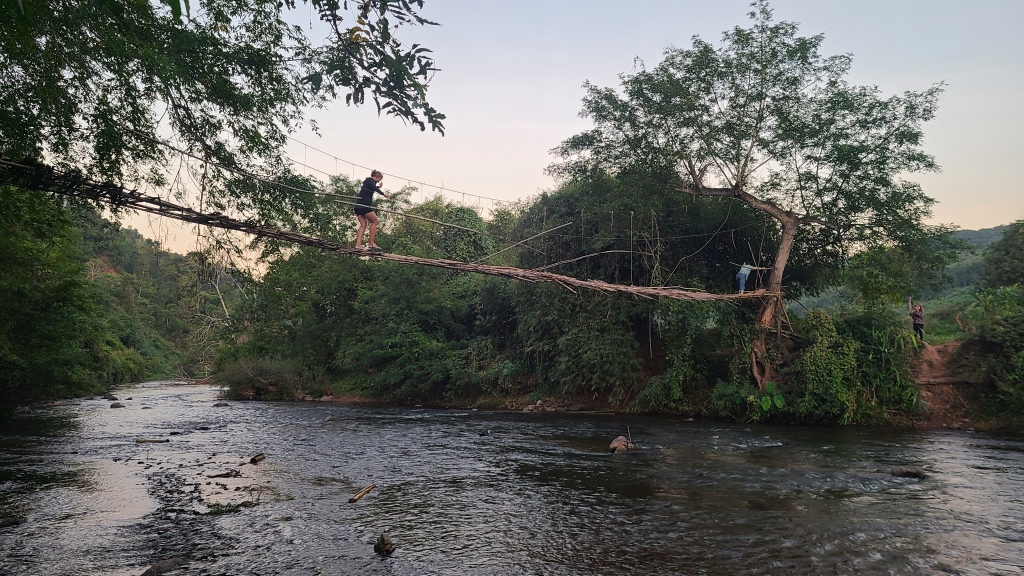
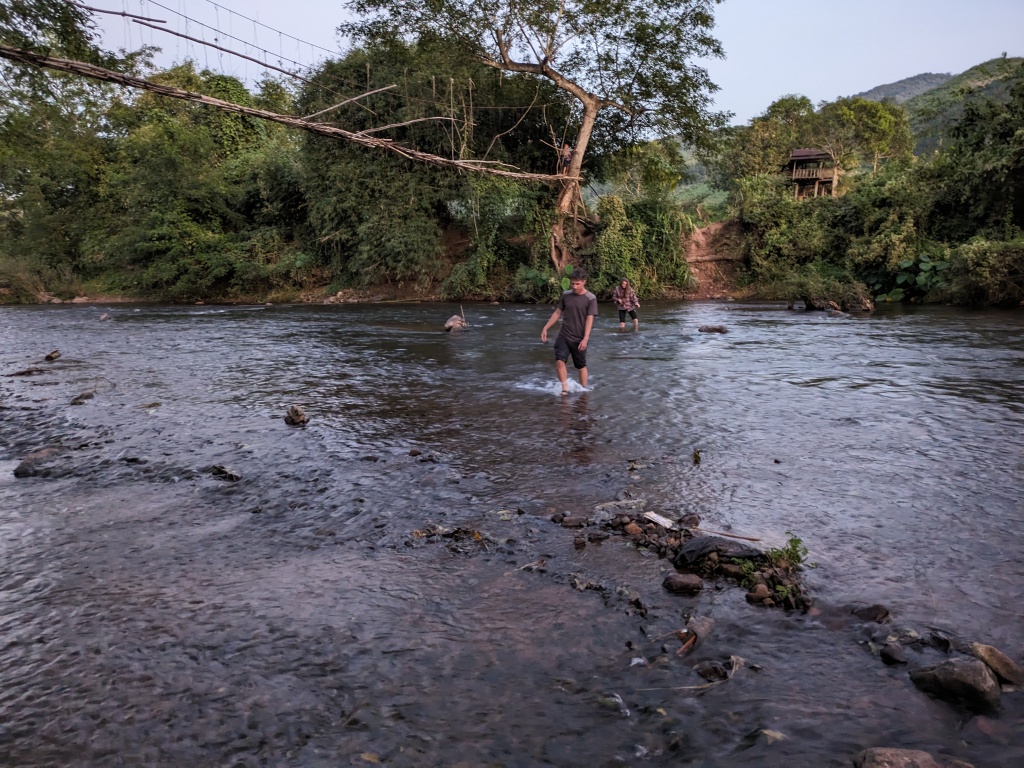
After dinner, we gathered around a fire and watched a show put on by the village children. They showcased their traditional dancing in costume, accompanied by some less-than-traditional music; at one point, there was an electric guitar, and we even heard a modern Laos tourism song with some English. The dancing was very cute, and they even got us to join in a few times in a big circle around the fire, which was slightly awkward and very fun. The show ended, and the kids put on their favourite electronic dance music, sharply out of place in this rustic village, but it set the tone nicely for a fire-side dance party – perhaps my favourite moment of the entire trek. After playing a few fireside games with my trekking companions, it was time for bed in a significantly more comfortable bed than the previous night. This time, we had some squishy mats and pillows in our bamboo loft.
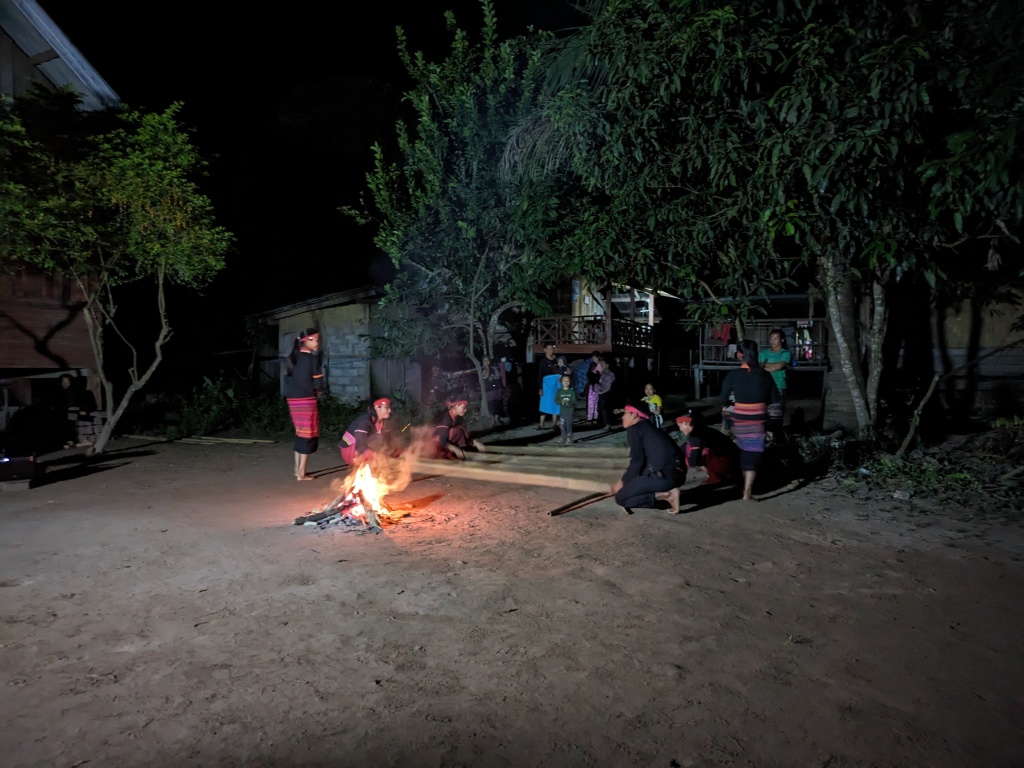
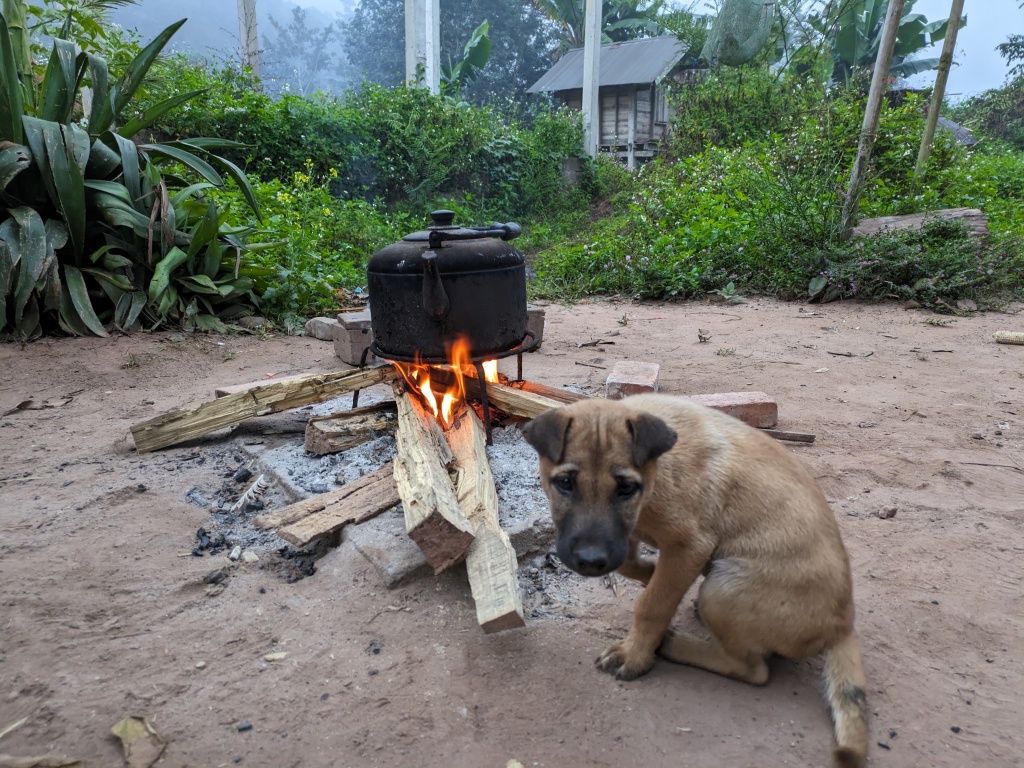
On the morning of the final day, after a delicious breakfast of scrambled eggs, rice, and instant coffee (we were all just so thankful for caffeine at that point!), we spent a bit more time exploring the village and its culture, which included admiring the many cute animals (puppies, cats, ducks, and chickens). We toured the town again, saw the school, learned about daily life of the villagers, practiced pounding rice with some of the local ladies, and got a chance for target practice with some small hunting crossbows.
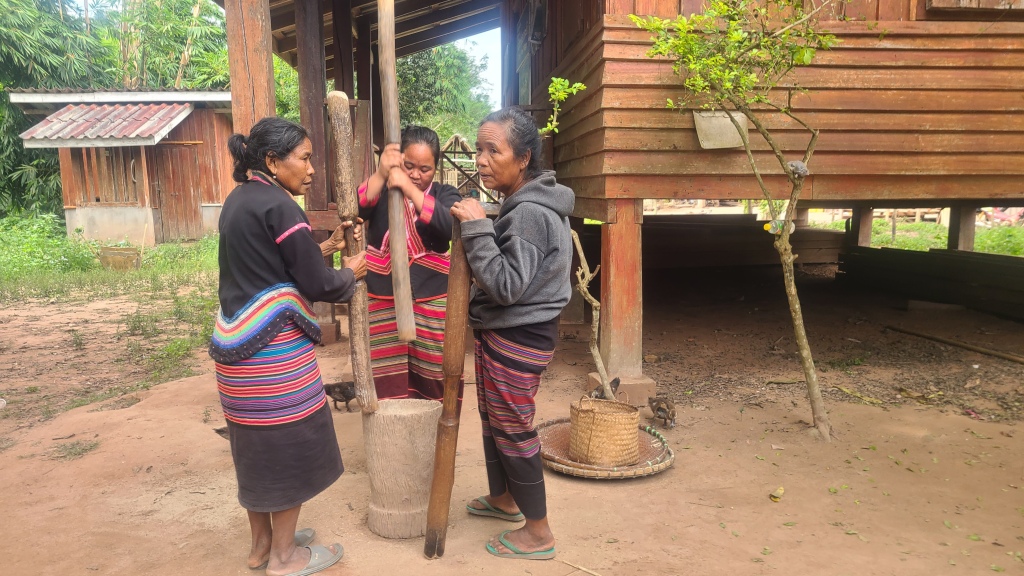
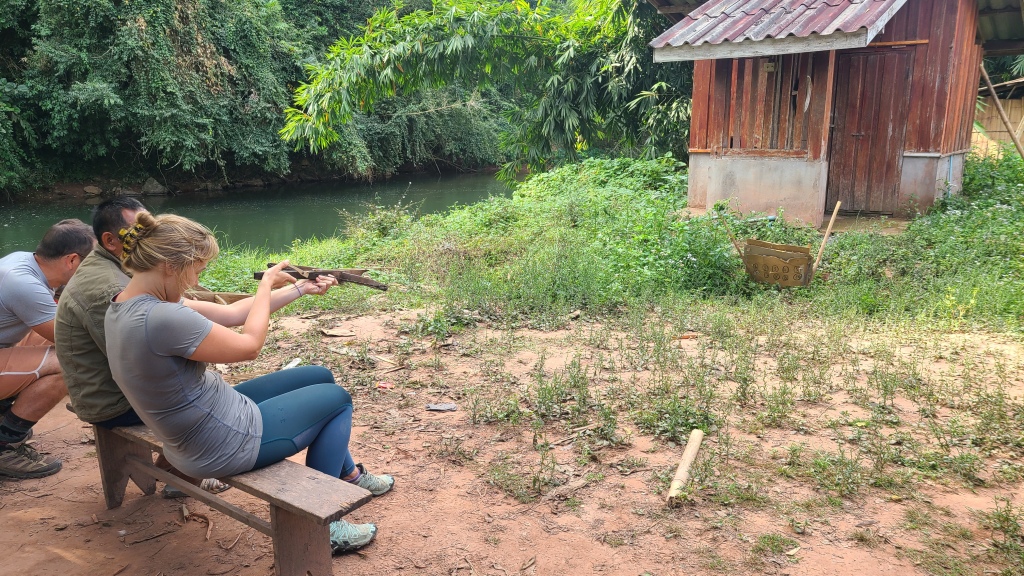
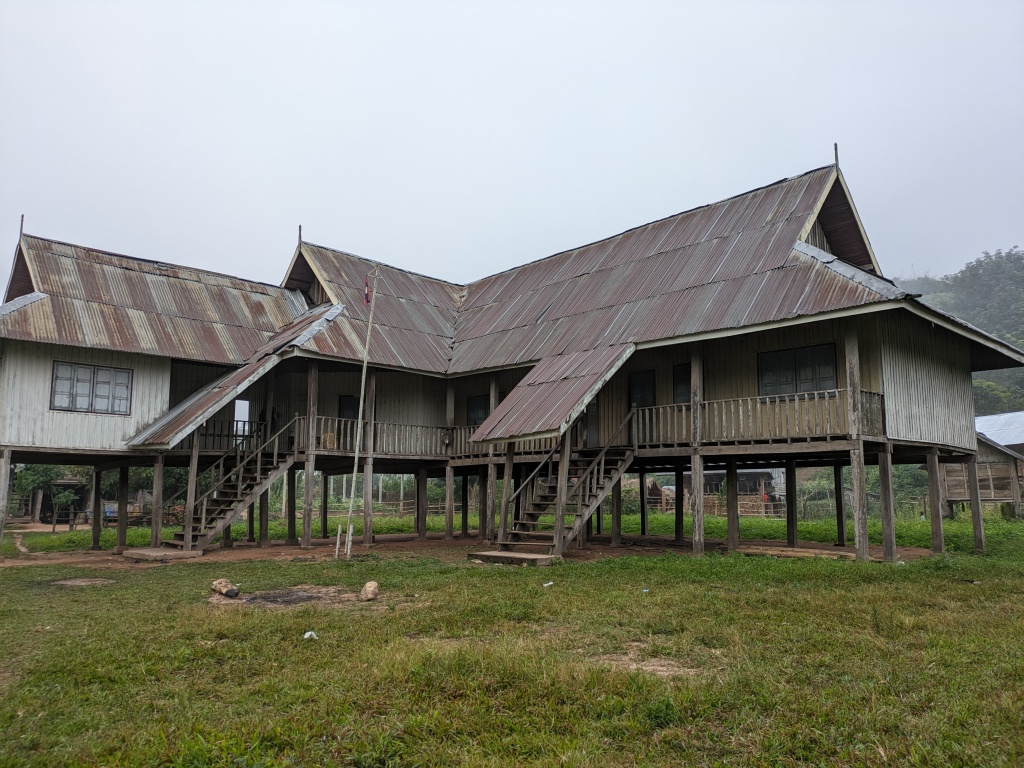
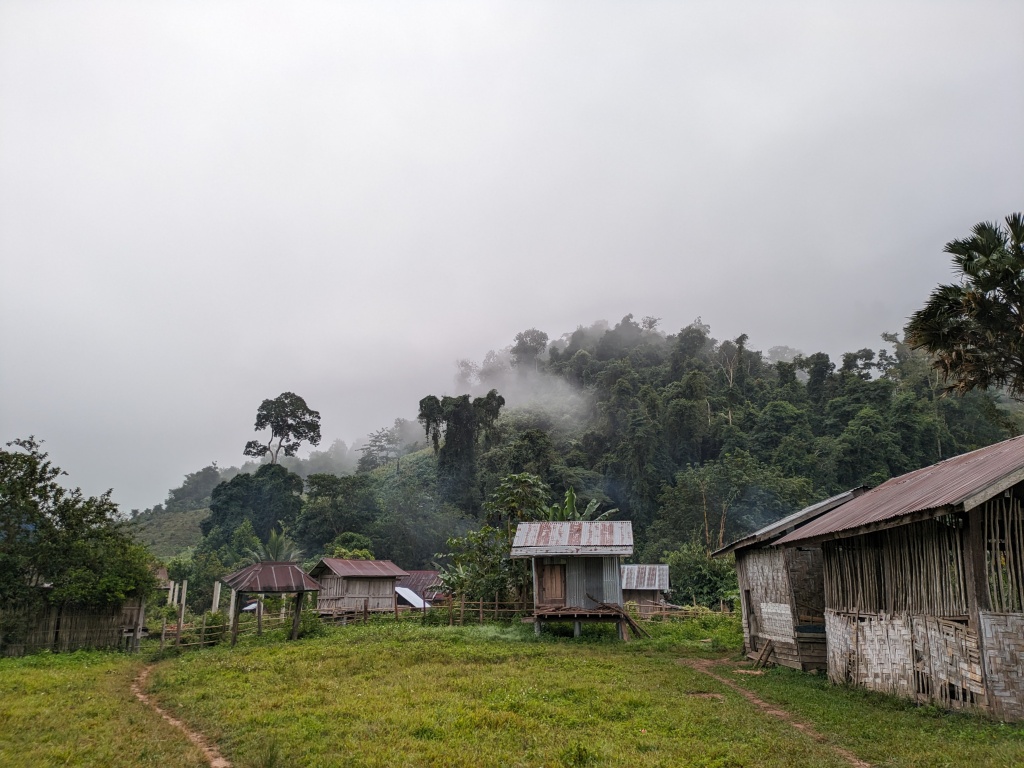
Afterwards, we set out for our final day of trekking. The trail started flat, with a short and hot uphill to our lunch spot (eggplant, potatoes and carrots, fried green, pork, and rice). After only another hour of hiking, we reached the road and pickup spot. A 45-minute drive left us back in town for about 2:30 pm.
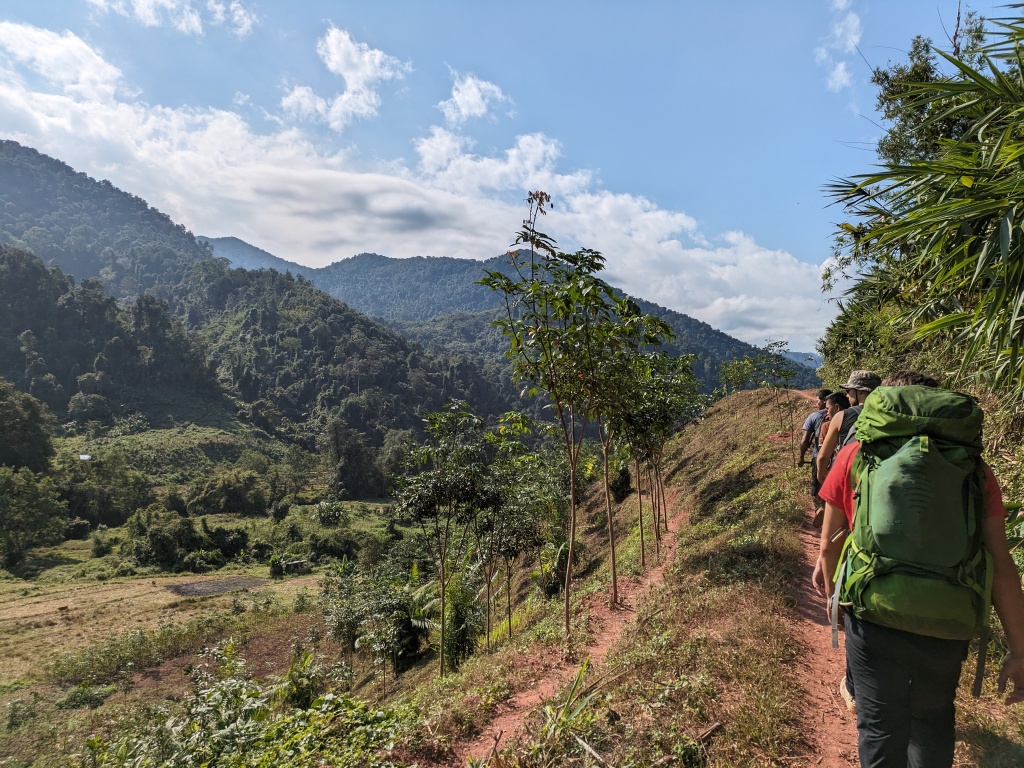
Our trek through the jungles of Luang Namtha was incredibly enjoyable. Some of my favourite memories include getting to know the other travelers on our trek, the fireside dancing with the villagers and other tourists, the recurrent singing of the Indiana Jones theme song, the night walk, the happy water with dinner, watching the village puppies playing together, spotting a blue bumblebee (what?!), and the death-defying bamboo bridge in the village.
After the rawness of the jungle and the simple, small-town life in Luang Namtha, I’ll confess that I was very excited for some modern comforts in our next destination: Luang Prabang, perhaps the most famous city in Laos. Luang Prabang’s French-inspired downtown next to the massive Meekong river is a UNESCO World Heritage Site. The streets are full of bright and colourful colonial buildings, and its long relationship with France has left the city packed with cafes and pastry shops. While many of the places we’d visited so far in South-East Asia are former French colonies (French Proctorates), the relationship is often faded and subtle; not so in Laos, and especially not in Luang Prabang. French is still the language of government in the country, with many older citizens still speaking it fluently, and encountering the many bilingual government signs (Laotian and French) across the country reminded us bizarrely of our home in Canada.
The Laos-China Railway
To reach Luang Prabang from Luang Namtha, we took a bus to the site of another interesting cultural collision: the Laos-China Railway (LCR). The LCR is a contentious topic in Laos. Connecting the Yunnan province of south-China to a brand new high-speed rail line that traverses the north of Laos down to the capital of Vientiane, the rail line is expected to produce a boom in economic opportunities. However, the economic impact for the average citizen, as well as those in surrounding communities, is mixed, as the LCR employs only Chinese citizens for its operations in Laos. In fact, local communities were not at all consulted when the line was built through their homes. Such a huge project came with a large price tag too, and China was more than happy to lend Laos the money. The surge in foreign debt has contributed to high inflation and a depreciating currency. While we didn’t get the opportunity to discover what the Laotians thought of the LCR, we knew that other travelers had similar misgivings as us about supporting the rail line and China’s economic hegemony in the region.
Laotian transportation is a study in extremes. As Laos is the least developed country in the region, its road network leaves much to be desired. ‘Buses’ in Laos are actually mini-vans, and these will be packed to maximum capacity, with people even sitting in the aisles and on the floor. The roads are slow going: they wind torturously around the many mountains, and they can never pick up speed due to the many potholes and severe sections of road damage. Due to the sheer painfulness of some of the bus routes, we did elect to ride the LCR a few times, and were able to witness first-hand the highly modern operation run to Chinese efficiency standards. And boy are they efficient. From the airport-style security checks, to queuing at the platform gates, to the actual train departure, everything runs accurate to the minute.
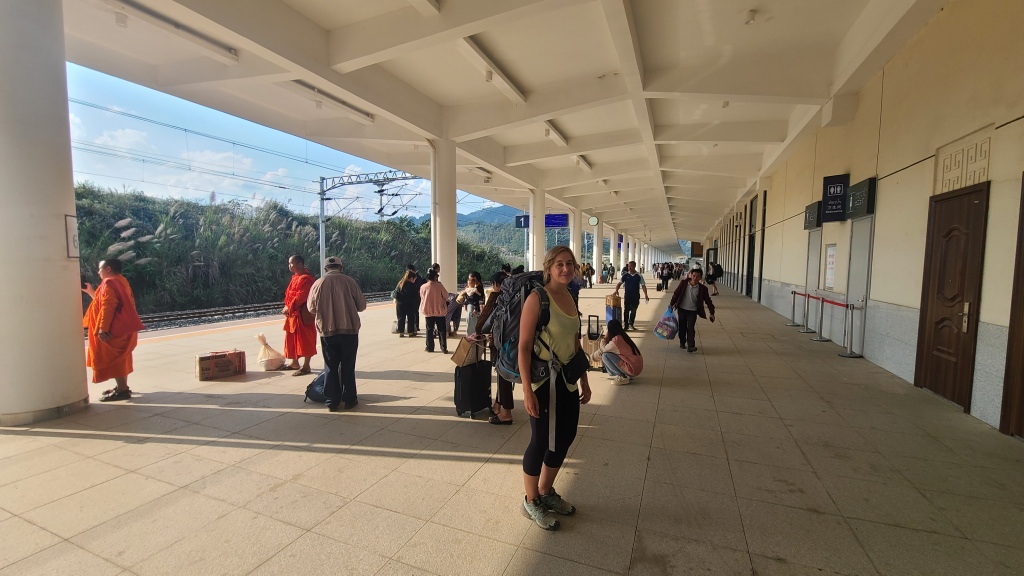
Riding the LCR did give us the opportunity to better understand Laos and its geopolitical relationships. We were surprised by exactly how Chinese the operation was – case in point, the snack shop in the train station sold only food and drinks imported from China, and displayed prices in Chinese Yuen, not Laotian Kip. But as far as travel goes, navigating the station was easy, the ride was unbelieveably smooth (at 150 km/hour!), and the view out the window of the quiet countryside and stunning limestone cliffs nothing short of jaw-dropping (when we weren’t barrelling through one of the hundreds of tunnels, that is). Overall, what should have been a 7-hour bus ride from Natuey to Luang Prabang ended up being an hour-fifteen train ride. After months of travel being synonymous with long bus rides, it felt almost surreal to be stepping off the train in Luang Prabang after so short an interval.
Luang Prabang
We arrived in downtown Luang Prabang near sundown, after a 20-minute shuttle ride from the train station. After noting some recommendations from Keagan, the solo American we had met on our Luang Namtha jungle trek (who had coincidentally booked the exact same train as us), we wandered the streets to find an available hotel. Fortunately, the downtown is not big – only about 1.5 km from end to end – and is full of guesthouses, restaurants, and shops. After lots of travel and a quick pace through the towns of northern Thailand, we were eager to slow down, so we booked a nice guesthouse for 6 days and settled in to enjoy the city comforts at a slow pace.
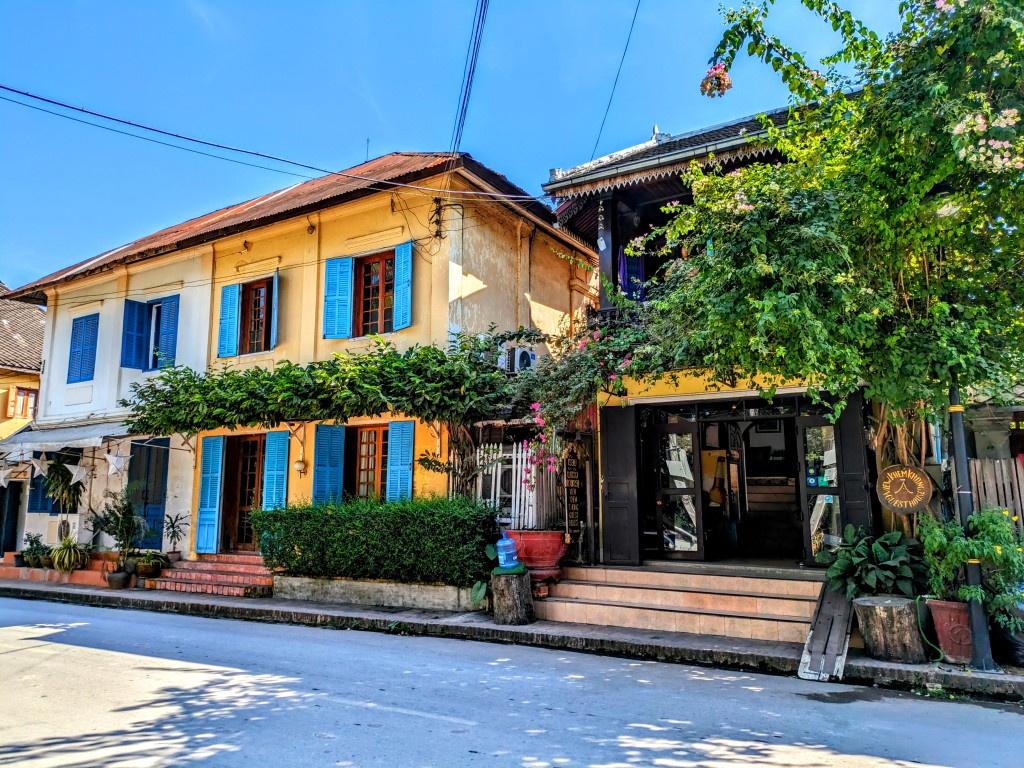
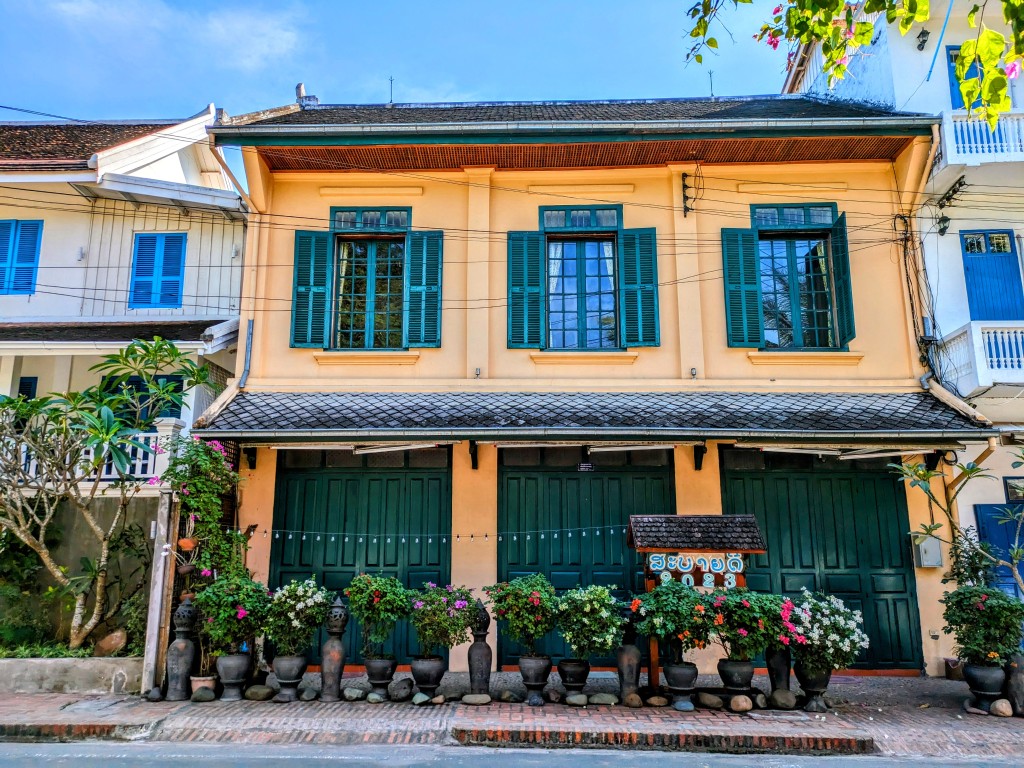
We spent most of our time in Luang Prabang slowly exploring. The streets are full of character, and there were many excellent cafes and bakeries to occupy an afternoon. As we visited mid-December, I was excited to find a number of Christmas decorations up as well, even though the heat and humidity made it feel more like July. The historic center is packed with temples, and in the evening, this area comes alive with a large night market. Hundreds of stalls sell all the standard tourist souvenirs, and a huge street food market, featuring the famous Beer Lao on tap, was a nice place to spend the evening (if you can find an empty table, that is!). The morning market, a much more local experience, was worth a visit too for a cheap, local breakfast (rice noodle soup, a staple food for every meal in Laos).

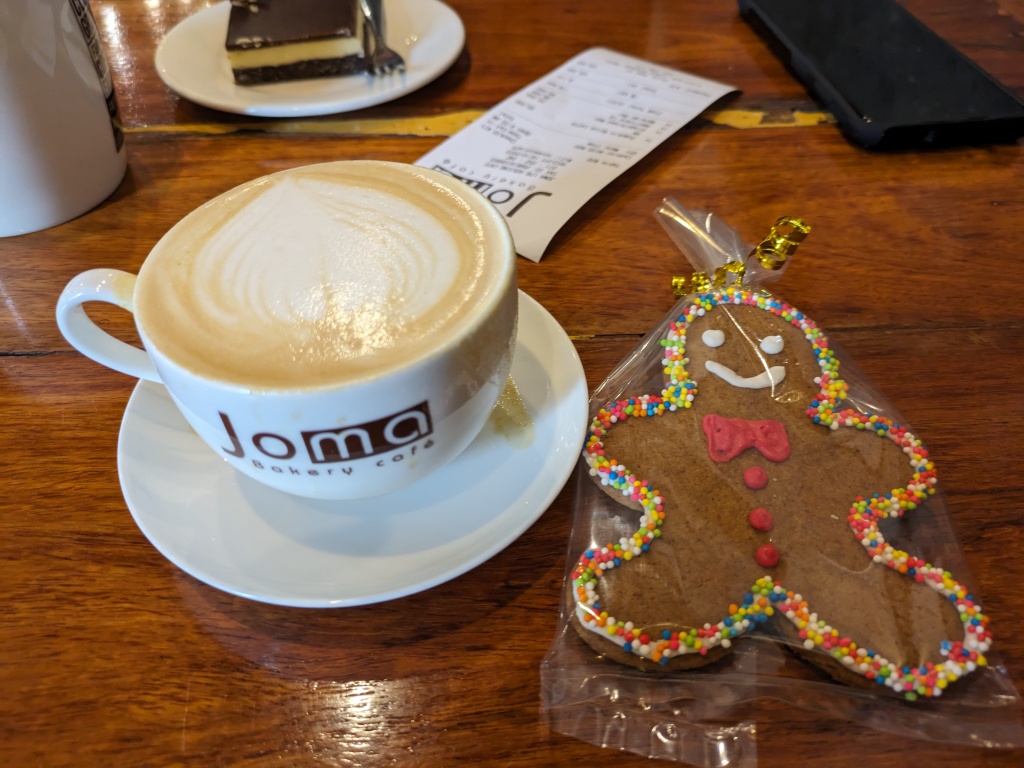
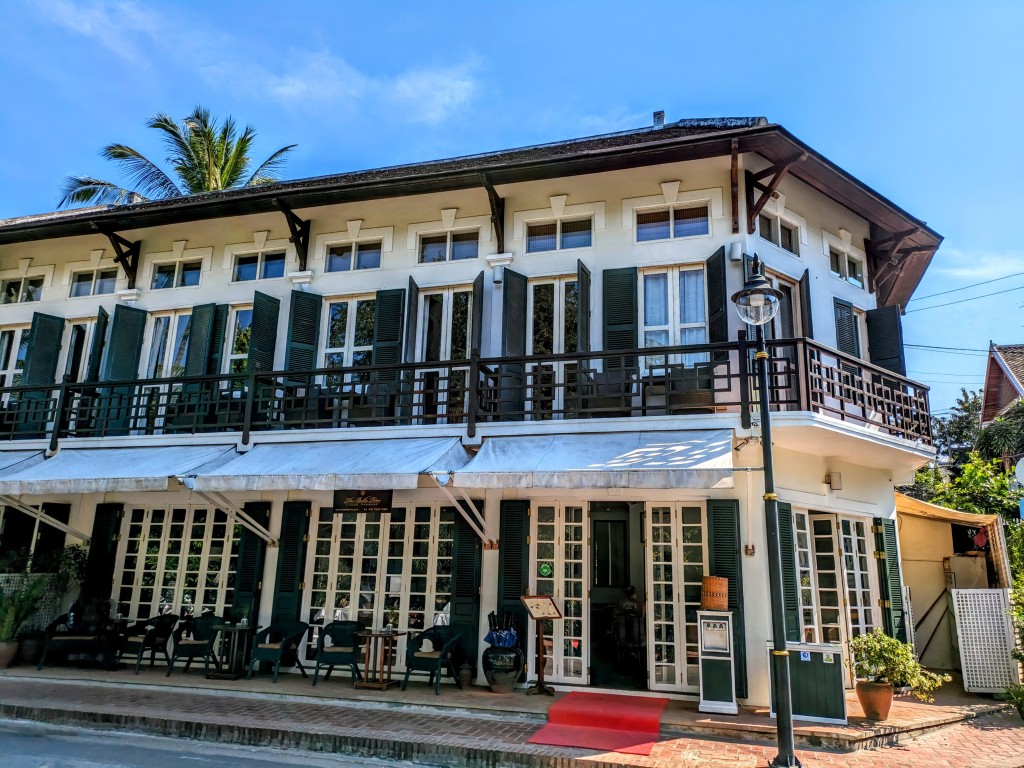
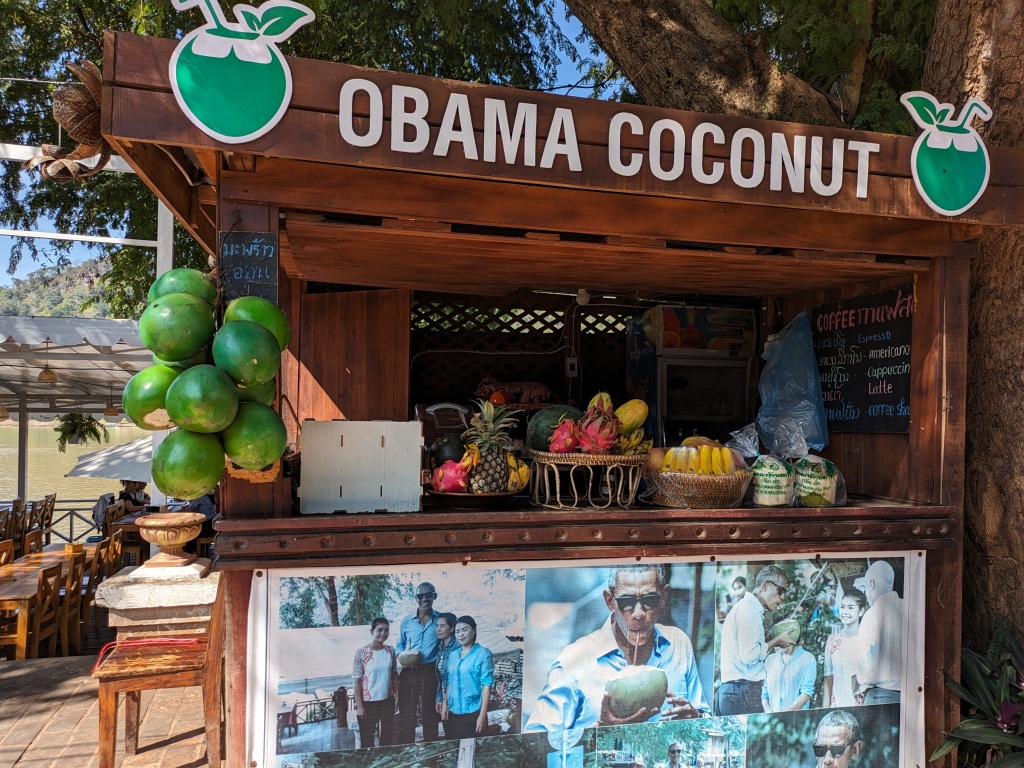

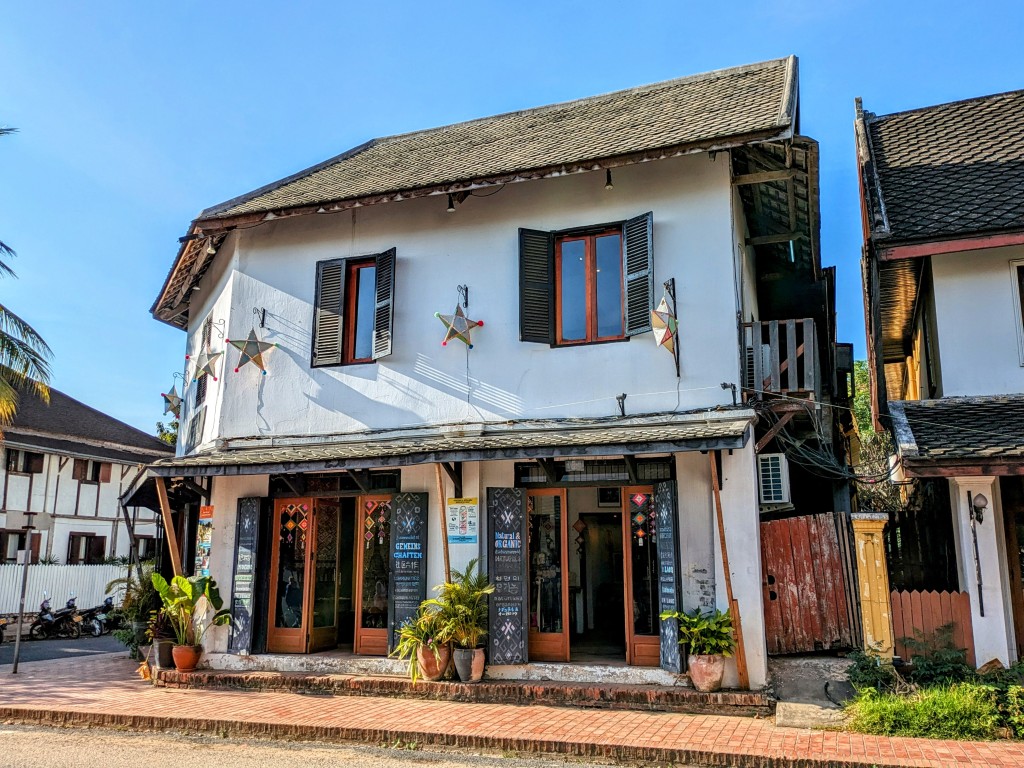
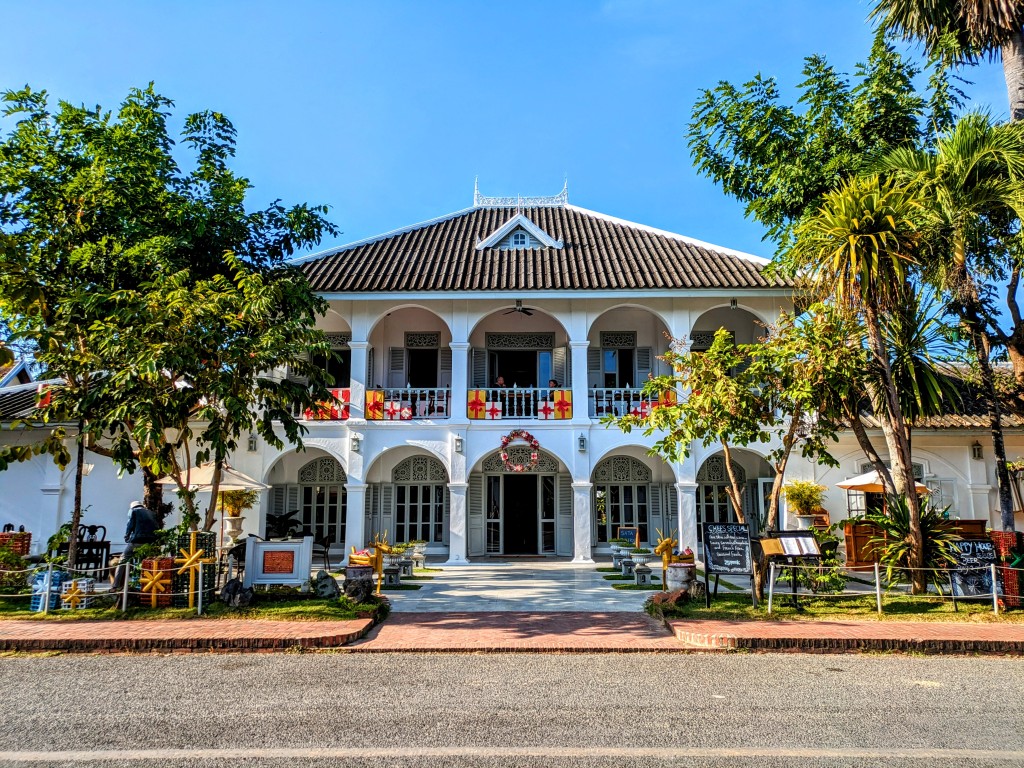
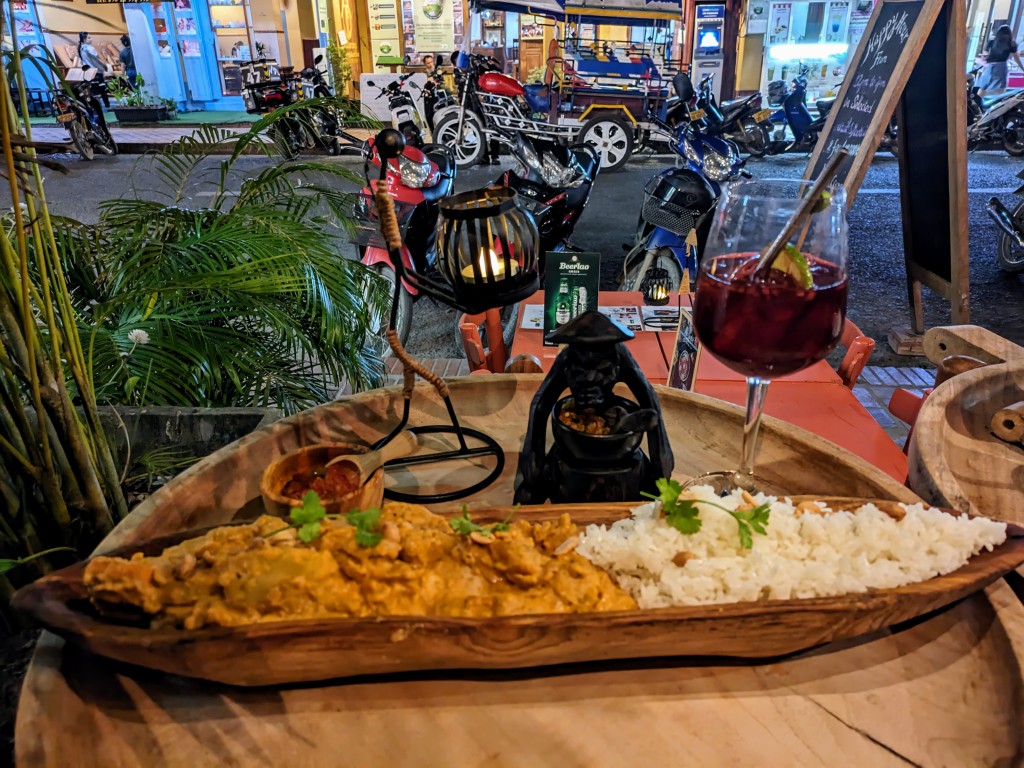

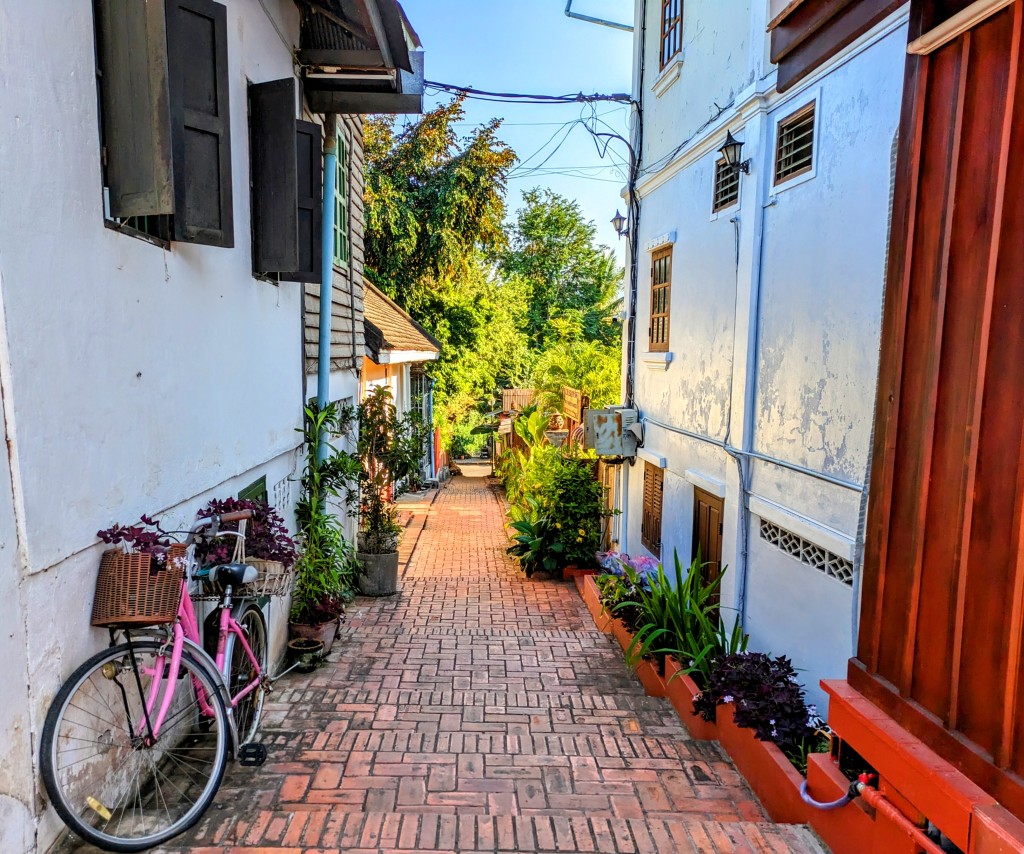
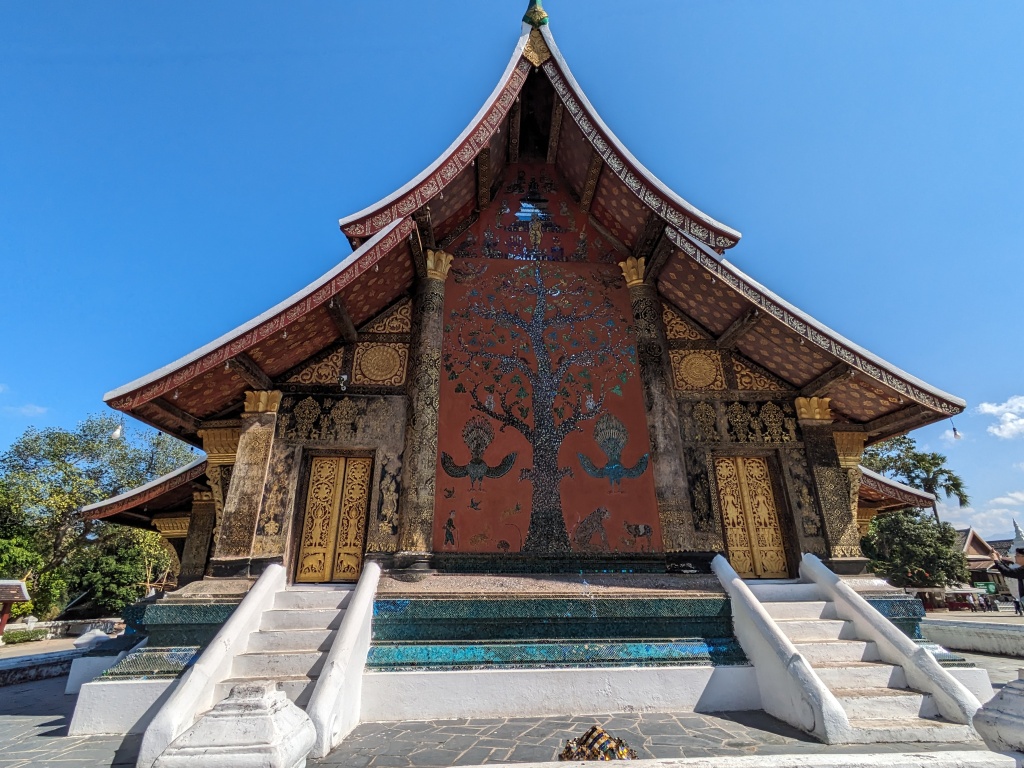
Our biggest excursion during our week in Luang Prabang was a motorbike trip to the famous Kuang Si falls, a set of tiered turquoise waterfalls next to a bear sanctuary. We found a pretty pink motorbike for rent in town, and set off in the morning, trying to beat the worst of the tourist buses that monopolize the falls after lunch. The ride was about an hour on the best road we had encountered so far in Laos (that’s those tourist dollars at work, I suppose). Once at the falls, we elected to walk about 20 minutes up the hill to the falls entrance (there is a shuttle, but, you know, exercise…).
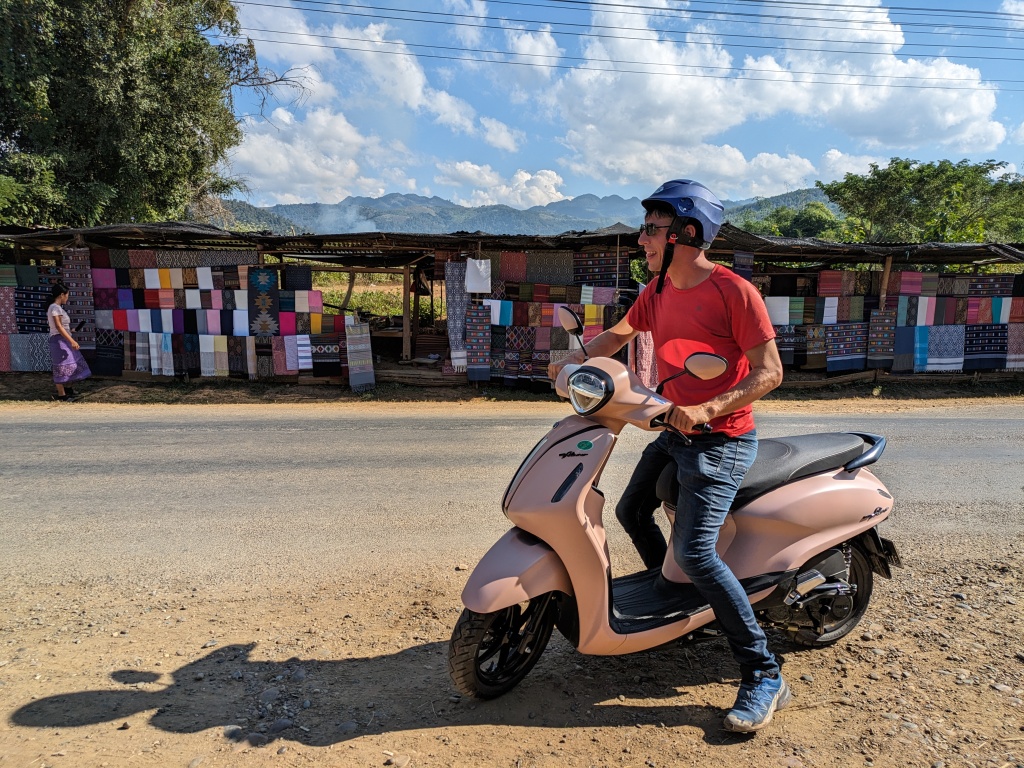
Before beginning the falls trails, we took a walk through the adjacent bear sanctuary. This organization is dedicated to rescuing and caring for previously captive bears being exploited as part of a number of illegal industries. They can not be released back into the wild unfortunately, but are given a comfortable life in the sanctuary. The bears we witnessed were sun bears – black with a distinctive white chevron on their bodies, and a little smaller than our Canadian black bears. I was thrilled to see them.
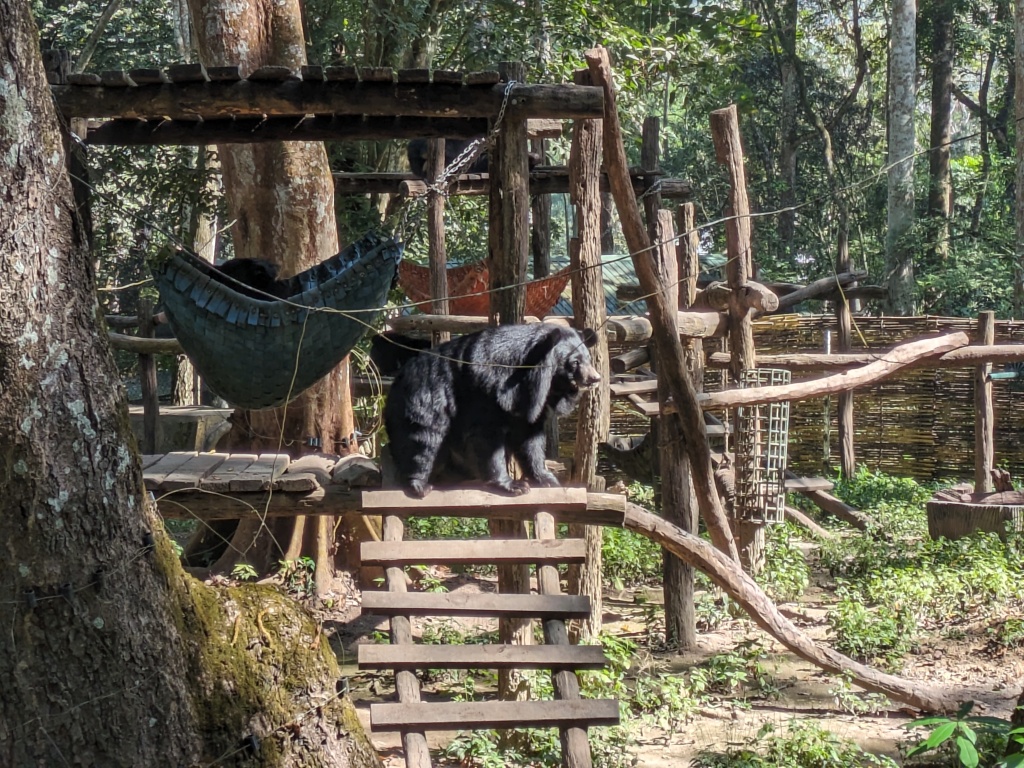
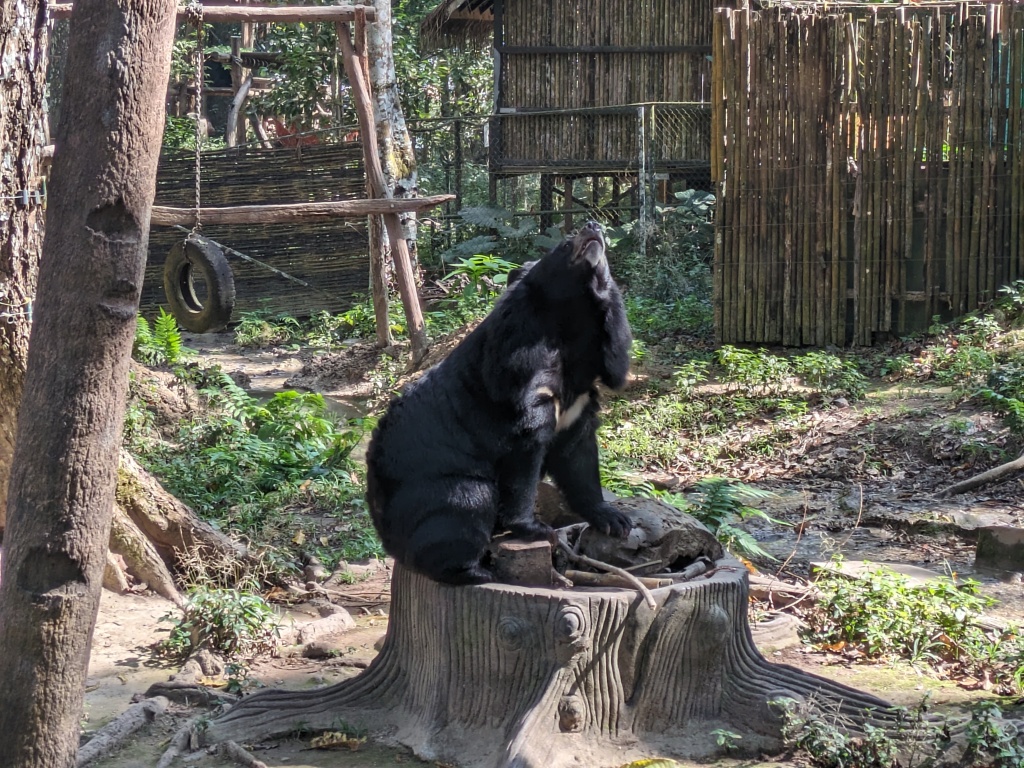
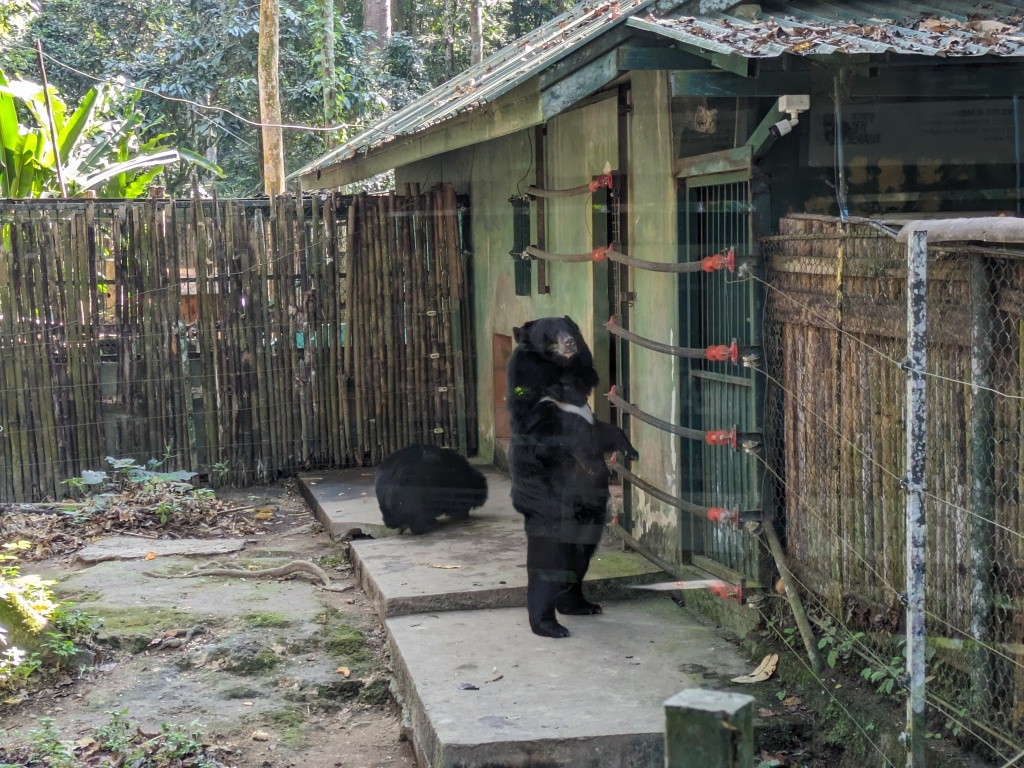
We spent some time walking the various Kuang Si falls trails, stopping for photos, but not for any swimming, as we heard the water is surprisingly cold. Past the largest of the falls, we hiked up a short and steep trail to the pools up top and explored the mangrove forest for a while in relative quiet, as not many tourists attempt the hike. After soaking up the cool colours, we headed back to our bike and headed off for our lunch spot: a little restaurant on the riverbank with an unbeatable view of the Meekong river.
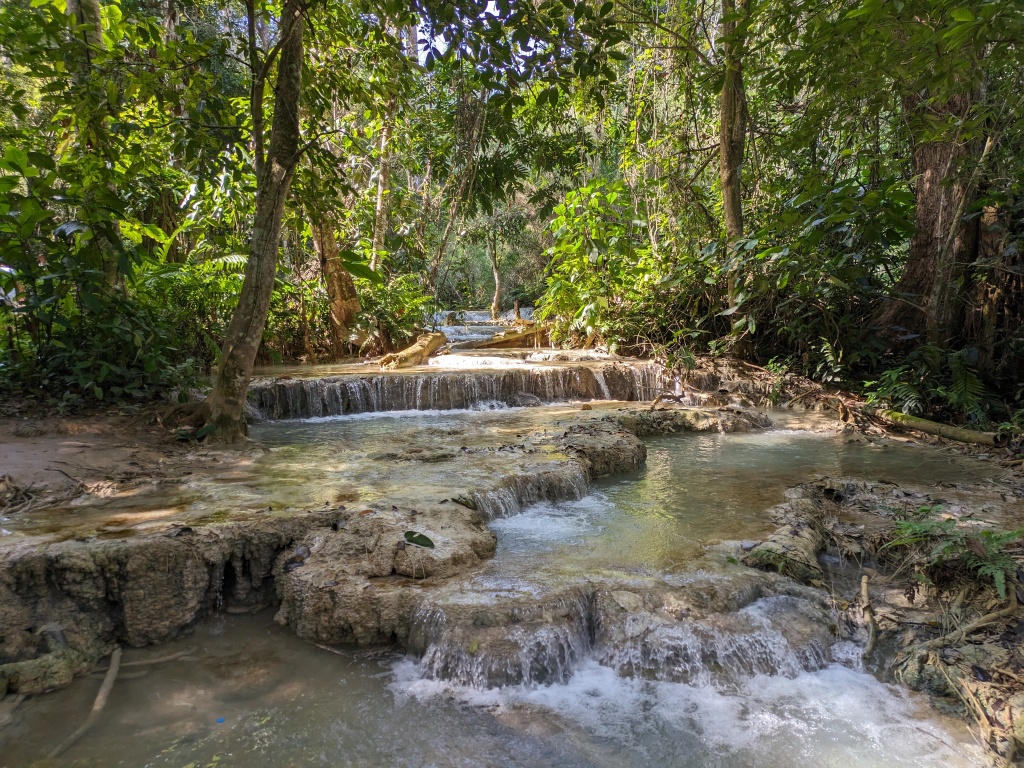

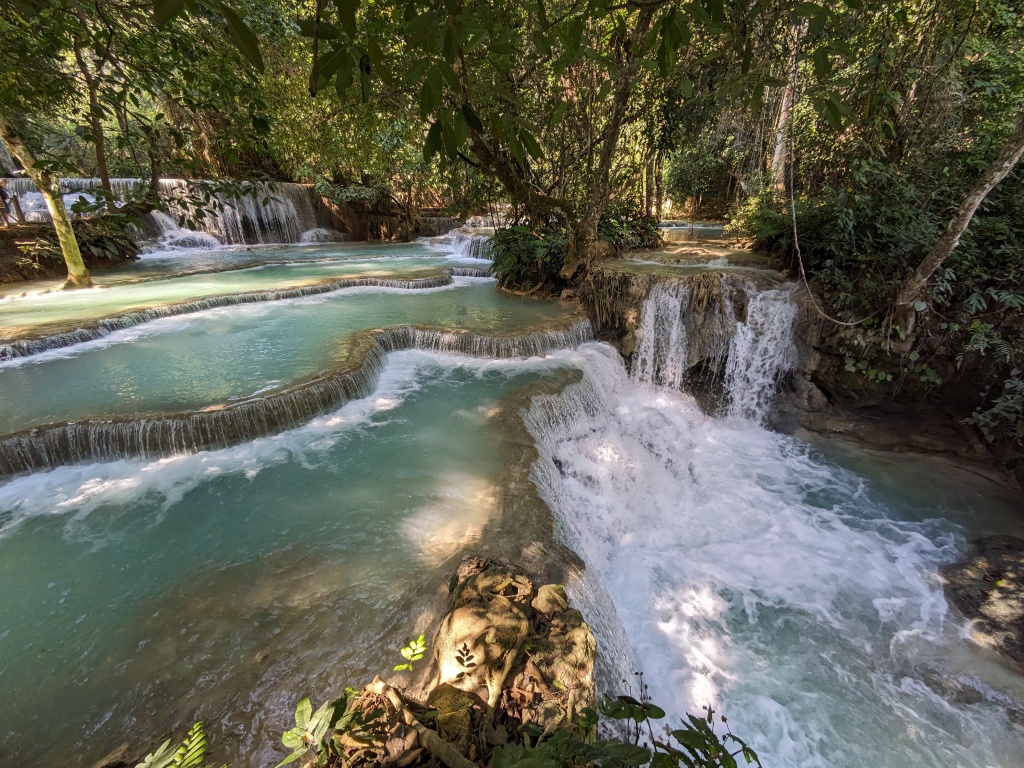
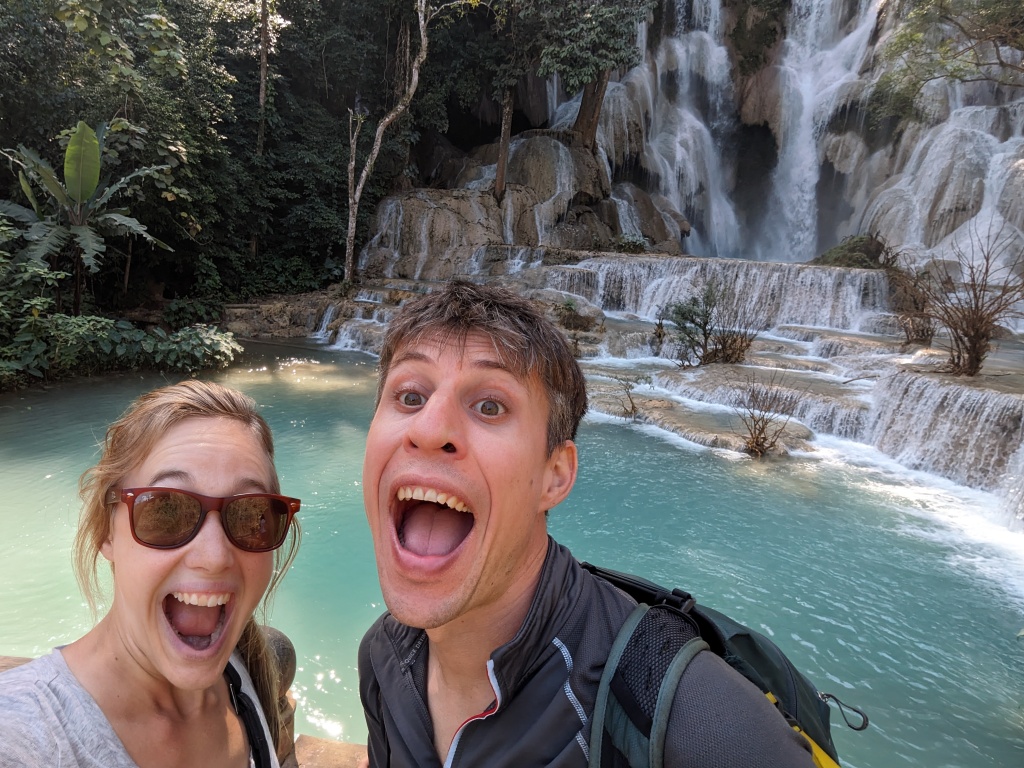
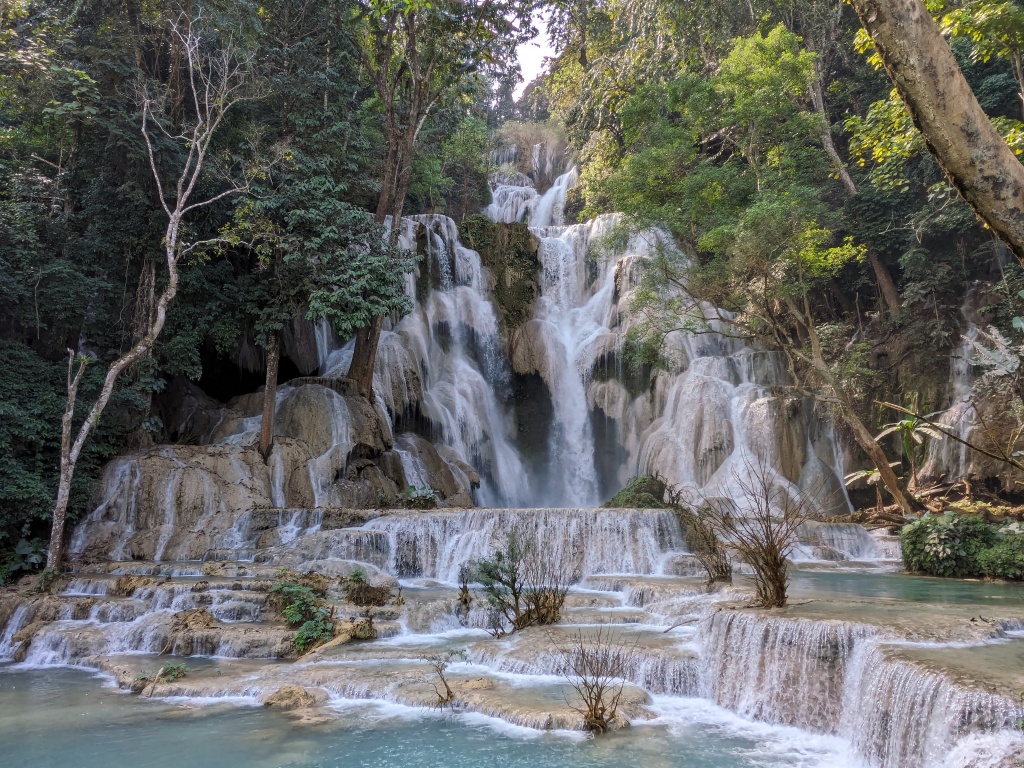

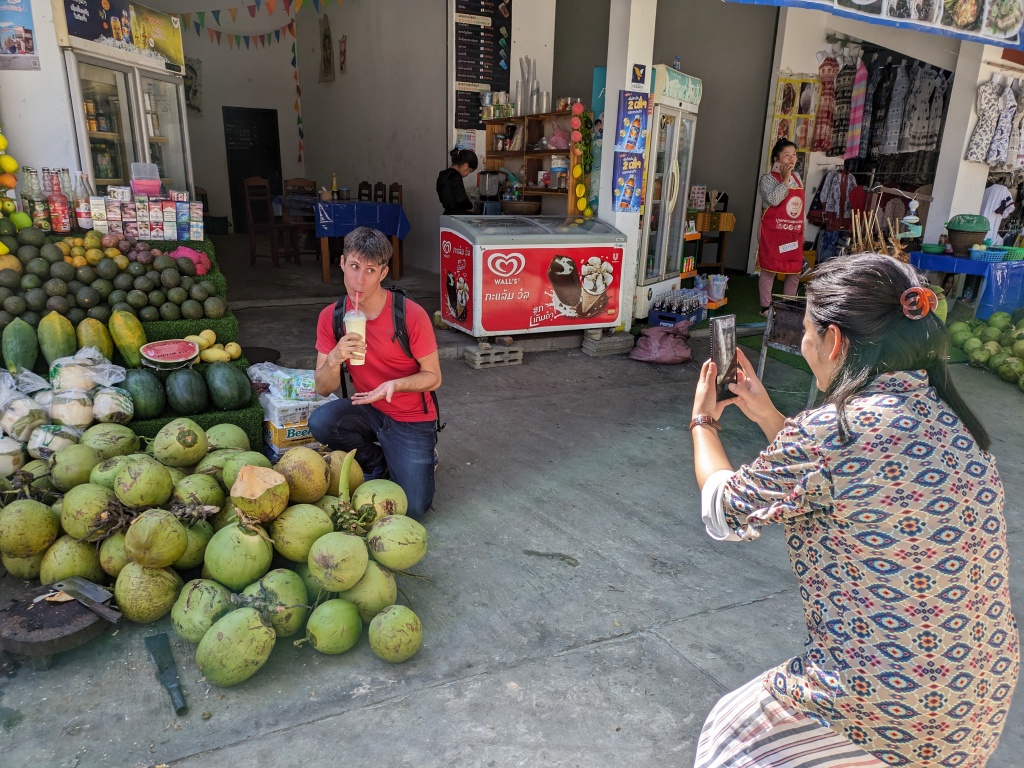
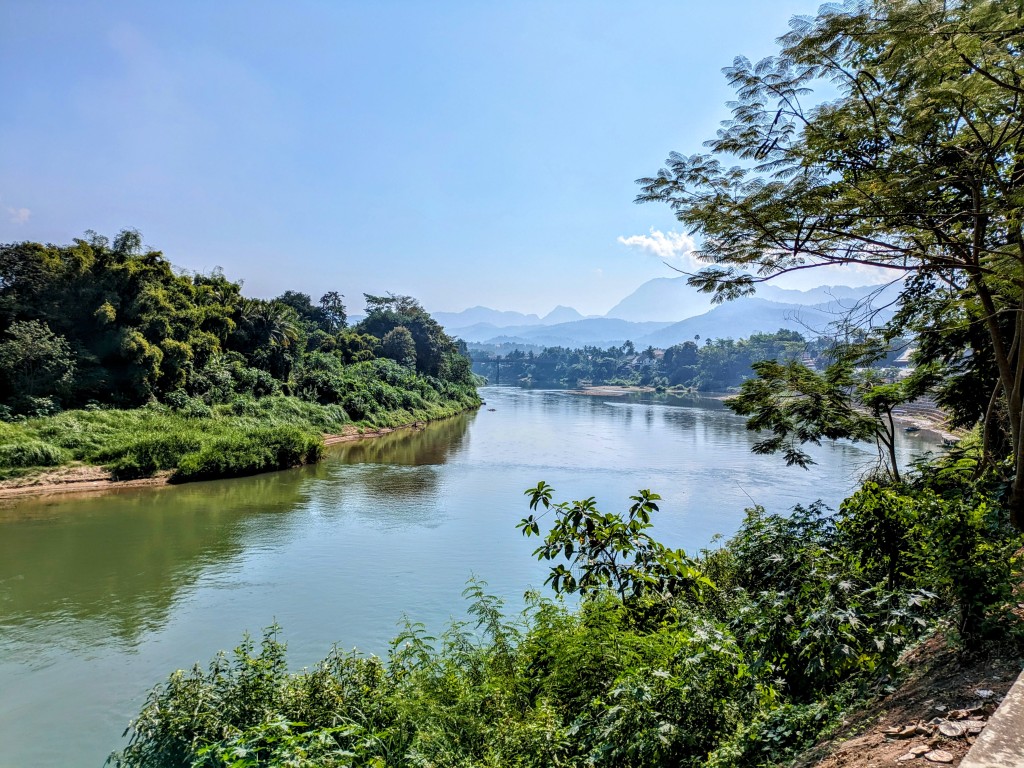
After some relaxing days in Luang Prabang, it was time to continue our journey through Laos. Our next stop? Back to small town life in Nong Khiaw, an outdoor paradise. More to come!


Well written, love the pictures too.
Glad to see you two touring now. We did meet lot of young people in Colombia doing the same. See you Soon, love Ken & Lisa
LikeLike